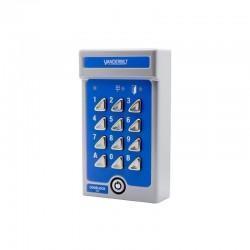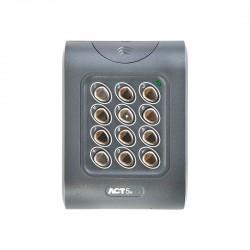The access control industry in the UK is evolving at an increasing rate. With some forecasts putting annual growth rates at between 7-10%, it’s an industry with high growth potential over the coming years and likely to change the way we access built environments, especially with innovations in AI, data, security and a shifting regulatory environment. While mechanical locks and standalone keypads still have their place, the real growth is in smarter, more connected systems that offer convenience, compliance, and peace of mind.
Whether you’re a facilities manager, installer, or a security buyer trying to plan ahead, here are 10 access control trends to keep an eye on in 2025.
1. Cloud-Based Systems Are Becoming Standard
If you’re still running access control from an on-site server, you’re behind the curve, at least you are in relation to the adoption of cloud-based systems. Cloud-based access control is on the rise, and with good reason. It offers remote management, real-time updates, easier scaling across sites, and usually a lower upfront cost. Expect more businesses, especially those with hybrid or flexible working patterns, to move their systems to the cloud this year.
2. Biometrics Are No Longer Niche
Fingerprint scanners and facial recognition used to be high-end or specialist kit, to the point where many of us of a certain age would once have thought this technology to be more in-line with a futuristic sci-fi world. Now, they’re showing up in everything from schools to hospitals to logistics sites. The combination of convenience and security makes them a solid alternative to traditional tokens or cards, especially where hygiene is still a concern post-pandemic and management of cards, fobs and tokens is an administrative headache. Whilst we’re seeing a greater adoption of biometrics and facial recognition, there are concerns around data security and user privacy as cyberattacks are becoming more commonplace in today’s world.

3. AI Is Quietly Transforming Access Control
This trend flies a little more under the radar, but still important. More systems now use artificial intelligence to detect anomalies, flag up unusual patterns, or even automate responses. AI helps security teams move from reactive to proactive, without needing to be glued to a screen 24/7 and this is likely to be a major emerging trend over the coming months and years. And that’s not to mention the potential here for AI to analyse a building’s data in real-time to improve energy efficiency and navigate the complexity required for modern access credentials.
4. The Shift from Cards to Mobile Devices Is Well Underway
Cards and fobs are still going strong, but we’re seeing a clear move towards mobile credentials. Using a smartphone for access is quicker, more secure, and easier to manage remotely. As we make our way through the 2020s though, expect more sites to ditch plastic cards in favour of mobile apps, especially where visitor access and quick changes are needed. This not only improves efficiency but is a user experience being demanded by a public who increasingly use their mobile devices to manage all areas of their lives.
5. System Integration Is No Longer a ‘Nice to Have’
Access control is now expected to play nicely with CCTV, alarms, HVAC, lighting, you name it. Whether it’s for security, energy efficiency, or user experience, integration is driving demand for open protocols and smart building compatibility. With some major shifts in work patterns, security needs and regulation, full integration is becoming paramount given the diverse functions and needs of those using a built environment.
6. Touchless Is Here to Stay
The demand for contactless access didn’t disappear when COVID did. From gesture-based sensors to mobile entry to voice-activated systems, we’re still seeing strong interest in hygiene-friendly solutions, especially in healthcare, hospitality, and public buildings. It also goes beyond hygiene to some degree, the ease of access using touchless systems is again something that a fast moving tech-savvy public will likely grow to expect.

7. ACaaS: Subscription Models Are Gaining Ground
“Access Control as a Service” isn’t just a buzzword. Subscription-based models are on the rise, with businesses opting for manageable monthly costs instead of big upfront installs. It also takes the pressure off internal IT teams and gives buyers the flexibility to scale up (or down) as needed. The ACaaS model also ensures that buildings will be more up-to-date in terms of technology and meeting future regulatory requirements, something that a shifting culture around security and safety demands.
8. Compliance and Data Security Are in the Spotlight
GDPR, the Data Protection Act, Martyn’s Law… regulations are tightening, and organisations are under pressure to prove they’re handling access and identity data properly. Expect more emphasis on audit logs, encryption, and systems that support data governance from day one. The regulatory environment has evolved rapidly following events such as the Grenfell fire and the Manchester Arena attack. This means the regulatory requirements of built environments should be seen as somewhat fluid over the coming years as new guidance and regulatory frameworks are deployed by government and governing bodies.
9. Sustainability Is Starting to Influence Spec Decisions
It’s not always front of mind when specifying a maglock or reader but it should be. Low-power consumption, recyclable components, and energy-efficient operation are becoming part of access control conversations, especially on larger construction or fit-out projects tied to ESG goals or BREEAM certification. With over 20% of carbon emissions coming from buildings, even small efficiencies found in buildings across the country will have a material impact on bringing down emissions.
10. More Markets Are Buying In
Access control isn’t just for big office blocks and government sites anymore. Demand is growing in residential, co-living spaces, student housing, logistics hubs, and even high-end homes. It’s not unusual to see video intercoms, app-based smart locks, or remote-access systems in buildings that wouldn’t have touched this stuff five years ago.
Final Word
The UK access control market is heading into a growth phase, with technology, compliance, and customer expectations all shifting fast. Technology in particular, partly on the back of other general tech trends, is driving adoption of more advanced systems as expectation of users moves further towards ease and convenience. Whether you’re supplying, installing, or specifying systems, it pays to stay ahead of the curve and to think beyond just the hardware.













Comments